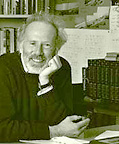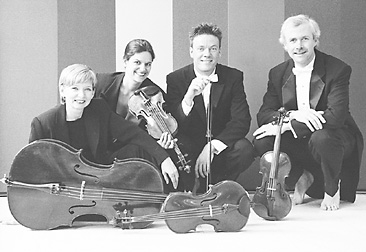Redefining the String Quartet: A Marathon Concert of R. Murray Schafer's Seven Quartet by Philip Ehrensaft
/ December 1, 1999
Version française...
Haydn's pioneering work in defining the string quartet was part of the
Enlightenment's revolt against the established aristocratic order. The
hierarchy of conductor and musicians in the ensemble, reflecting the
hierarchy of the ancien regime, was replaced by a dialogue among four
colleagues with equal voices. Two centuries later, innovators like Ligeti
demonstrated that the sonic combination of two violins, viola, and cello
was a superb vehicle for radically new strategies of composition.

One of the remarkable quartet cycles in the international post-war
repertoire has been created by Canada's R. Murray Schafer. Olga
Ranzenhofer, the artistic director of Le Quatuor Molinari and solo violinist
for the SMCQ, has organized a marathon concert of Schafer's seven string
quartets at Salle Pierre-Mercure on December 11, beginning at 6:30 p.m. Le
Quatuor Molinari includes Ranzenhofer and three members of L'Orchestre
symphonique de Montreal: violinist Johannes Jansonius, violist David
Quinn, and cellist Sylvie Lambert. Roundtables organized at La Chapelle
historique du Bon-Pasteur will be held on December 9 and 10. Schafer, the
members of the Molinari Quartet, and Montreal composers and
musicologists will talk about each of the seven quartets, as well as
Schafer's work as a whole.

The composer's career has been rather iconoclastic. His contacts with
Marshal McLuhan had a profound influence on him. When he taught at UBC,
he pioneered multidisciplinary research on the ecology of sound, charted
new strategies for music education, and invented a "theater of
confluence," which united musical, visual and literary arts. All three of
these endeavors are inseparable from his accomplishments in music.
Ironically, Schafer did not look forward to writing his commissioned first
string quartet, which was published in 1970. But he ended up creating a
new form for the quartet, tightly related to his work on the ecology of
sound. The First Quartet was awarded the prestigious Prix Arthur
Honneger in 1980, making Shaefer one of the few North American
composers so honored.
Ranzenhofer sees the seven quartets as one long work, written over 28
years and united both by musical themes and spatial sonics involving the
placement and movement of the quartet players. Shaefer's theatre of
confluence has also played an essential role in the quartet cycle. Not only
is the sixth quartet organized around episodes related to 108 Tai Chi
movements, but it is also played while a Tai Chi master executes each of
the movements on stage.
The seventh quartet, structured around interaction with a soprano singing
from the actual diaries of a schizophrenic, goes further yet towards
integrating composition with theater of confluence. Le Quatuor Molinari
commissioned this quartet and premiered the concert version at the
Strings of the Future Festival. On December 11, the Molinaris will present
the theatrical version of this quartet. Each musician will wear a costume
of a different color, symbolizing fire, water, the spirit of the forest, light
and purity plus illness respectively. Guido Molinari has designed the
backdrops. Here the placement and movement of the musicians will be
pushed even further than in previous works.
The whole quartet cycle is inseparable from Patria, Shaefer's great,
ongoing work in the theatre of confluence. In the composer's own words:
"My idea was that two principal characters, a man and a woman, would
engage in a search for one another through a labyrinth of different
cultures and social twistings almost as if they represented the split
halves of the same being... They might return with various guises and
different names but the quest for unity and the homeland they were
seeking would always be the same." Ranzenhofer points out that the
musical theme of the woman, Ariane, is literally the cord of Ariane that
most unifies Schafer's seven quartets into one long work.
Version française... |
|


